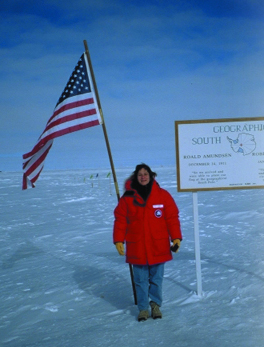 When Susan Solomon first heard
about observations of a hole in the ozone layer over the Antarctic in the 1980s,
the atmospheric scientist was surprised. So she and her colleagues at the National
Oceanic and Atmospheric Administration (NOAA) Aeronomy Lab in Boulder, Colo.,
set out to pin down how chlorofluorocarbons (CFCs) could have created the Antarctic
hole so unexpectedly fast. Their research eventually led to a global ban on
CFC production. For her work in determining those mechanisms and consequently
changing global policy, Solomon won the 13th annual Blue Planet Prize last June.
When Susan Solomon first heard
about observations of a hole in the ozone layer over the Antarctic in the 1980s,
the atmospheric scientist was surprised. So she and her colleagues at the National
Oceanic and Atmospheric Administration (NOAA) Aeronomy Lab in Boulder, Colo.,
set out to pin down how chlorofluorocarbons (CFCs) could have created the Antarctic
hole so unexpectedly fast. Their research eventually led to a global ban on
CFC production. For her work in determining those mechanisms and consequently
changing global policy, Solomon won the 13th annual Blue Planet Prize last June.
Susan Solomon, an atmospheric scientist, won the Blue Planet Prize last June for her work on the Antarctic ozone hole. The prestigious environmental award is given to two individuals or organizations every year by the Japanese Asahi Glass Foundation, along with 50 million yen (equivalent to about $460,000). Image courtesy of NOAA.
“I’m following in very big footsteps with very small feet,” Solomon said while speaking to reporters after the first public announcement of the award, made in Baltimore, Md., on June 23, at the first annual Climate Variability and Predictability (CLIVAR) meeting. Past winners include Wally Broecker of Lamont-Doherty Earth Observatory, for his work on climate and Earth systems, and James Lovelock, at Oxford University at that time, for his technological breakthroughs on atmospheric measurements and his part in developing the Gaia hypothesis of a “living planet.” Solomon’s co-winner this year is Gro Harlem Brundtland, the former director-general of the World Health Organization, who was recognized for her work on a U.N. report that led to the Earth Summit, an international environmental convention.
Solomon guessed that many of the scientists attending the CLIVAR meeting were inspired to pursue science the same way she was: by Jacques Cousteau. Solomon says Cousteau “made the planet come alive” to her generation. Because of his television programs, she knew she would be a scientist from the age of 10.
She discovered, however, that she did not like biology, Cousteau’s medium of choice. Instead, Solomon found that chemistry was the right mix to suit her palate. She left her hometown of Chicago, Ill., after completing an undergraduate chemistry degree at the Illinois Institute of Technology, to pursue graduate work in atmospheric chemistry at the University of California, Berkeley. After that, she says, she never left the West. Solomon has worked for NOAA in Boulder since receiving her Ph.D. in 1981.
In the early 1980s, the magnitude of the effect of CFCs on ozone was a surprise: Observations confirmed that the ozone layer over the Antarctic had been depleted by 50 percent over about a decade, not 5 percent over a century, as scientists had thought would happen. Solomon and her co-workers suggested that the interactions between chlorine from human-made CFCs and ozone were accelerated at the extremely cold cloud surfaces of the Antarctic, building on Nobel-prize winning work by Paul Crutzen, F. Sherry Rowland and Mario Molina. Solomon went to the Antarctic and Greenland to directly observe what was happening.
Solomon’s trips to the Antarctic led to a fervent love of the continent. “The Antarctic is the next best thing to another planet, [and] as close as I can get to space,” she says. “I was overcome by the majesty of nature and the incredible puniness of humans.”
Her work there led to what Solomon calls “one of the success stories of the 20th century,” the global ban on CFC production. Solomon compares current discussions of the global impact of carbon dioxide to the same issues that surrounded CFCs in the 1970s and 1980s. Both molecules have 100-year lifetimes and potentially long-lasting climate impacts. “If we’re creating a problem [with carbon dioxide], we will have to live with it for a long time,” Solomon says. With CFCs, “we knew that there could be a problem, that it would be small, [and] knew that we would have to live with it for at least half a century.” At the time, however, the benefits of the human-made compound seemed to outweigh the projected risks.
Continued impacts from past releases of CFCs include the depletion of the Arctic ozone layer by 25 percent, although the layer there has no hole as it does in the Antarctic. In the Northeast (specifically in Washington, D.C.), decreases in ozone of 5 percent have raised the risk to humans of skin cancer and other problems from exposure to UV light. And less ozone over the Antarctic might also be confounding expectations for climate change there, Solomon says, leading to an unexpected regional cooling. Solomon says she will probably be in her 90s by the time the ozone hole in the Antarctic closes, in 2050 or so.
Jim Mahoney, NOAA’s deputy administrator, says that Solomon’s “synoptic” scientific view and her reputation as a leading scientist made her “a widely applauded choice” to lead the science working group for the Intergovernmental Panel on Climate Change. As co-chair of the working group that assesses scientific information, Solomon will directly impact how science shapes the panel’s fourth report, due in 2007, which in turn will influence global policy decisions.
“I like the notion of serving the American people,” Solomon says. Nevertheless, she feels very strongly about the division between scientific observation and societal decision-making. “The role of science is not to make value judgments or policy,” she says. “It’s to inform people how things work.”

